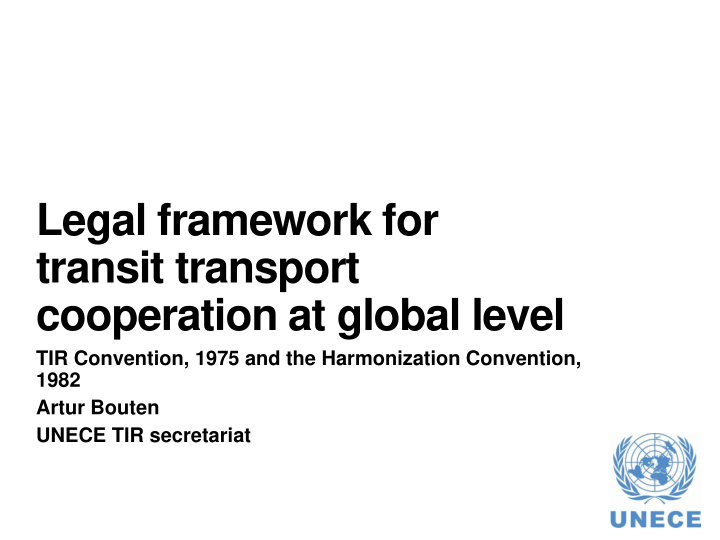



Legal framework for transit transport cooperation at global level TIR Convention, 1975 and the Harmonization Convention, 1982 Artur Bouten UNECE TIR secretariat
The TIR Convention, 1975 TIR Convention, 1975 • Establishes and regulates the only existing and operational global customs transit system • Administered under UNECE auspices • 69 Contracting Parties from 4 continents, among which Afghanistan, Armenia, Azerbaijan, Kazakhstan, Kyrgyzstan, Mongolia, Republic of Moldova,Tajikistan, The Former Yugoslav Republic of Macedonia, Uzbekistan • Pakistan recently acceded • China expressed interest to join • Border crossing facilitation through an internationally recognized and harmonized procedure with a single internationally valid customs document and guarantee • Effective revenue protection and security without excessive administrative burden for customs and time/cost losses for operators
International Convention on the Harmonization of Frontier Controls of Goods - 57 Contracting Parties - Latest accessions: Iran, Morocco, Tajikistan - Other LLDC: Armenia, Azerbaijan, Kazakhstan, Kyrgyzstan, Mongolia, Republic of Moldova, FYROM, Uzbekistan - Expressed interest to join: China
Objective and Scope To facilitate cross border transport of goods through nationally coordinated, internationally harmonized, shorter, reduced formalities and controls of goods at borders It covers: • All goods moved across borders (exported, imported or in transit) • All control services • All modes of transport • Specific provisions for certain transport modes and goods • Also addresses certain issues with regard to vehicles and drivers (international vehicle weight certificate, visa for drivers)
Concluding comments On some major routes: 57 % of transport time is lost at border crossings 38 % of transport costs are due to unofficial levies • Border waiting times also cost billions annually => • increasing the cost of goods for the end consumer, not to mention lost business opportunities. • harmful impact on the environment • Long waiting times at borders result in major human suffering for drivers blocked in queues for hours/days Border crossing facilitation is: • Key to international trade, exports and imports • Essential for growth and competiveness • A driver of regional integration
WTO TFA, TIR Convention and Harmonization Convention TIR Convention and the Harmonization Convention provide "ready to use" tools that are in line with the principles and objectives of the World Trade Organization Trade Facilitation Agreement and, thus, can be used as precursor to or as accompanying the implementation of TFA.
Access to UNECE legal instruments Open to all UN Member States Many non-ECE States are already Parties The UN Secretary-General is the Depositary To become a Party, deposit an instrument with the S-G No accession fee
Thank you Artur Bouten UNECE TIR SECRETARIAT Sustainable Transport Division 8-14, Avenue de la Paix CH-1211 Geneva 10 Switzerland Phone: +41 22 917 2433 Fax: +41 22 917 0614 Email: artur.bouten@unece.org
Recommend
More recommend